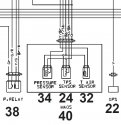well, I do not know the Mikuni throttle body, but typically you are not "sneaking" air by the ECU- it'll register more air going in and move to another area of the map (usually adding more fuel).
typically, a higher idle needs more fuel. (not always- as in the case that it's already too rich)
and if it does lean out, it might help- 'cause the bike does seem kinda rich anyway. OTOH, 2200rpm's is plenty.
*NOTE the below has been edited - see the original post in the quote from Trenchcoat85 below.
On these bikes, I think it's very possible to 'sneak' air by the ECU. They are pretty simple 6sensor EFI setups:
TPS - throttle position sensor
CTS - Coolant temp sensor
CPS - crank position sensor (besides telling the ECU when the crank is in a certain position, so I can send spark at the right time, it also provides engine speed information)
O2 - Oxygen sensor - although this is disabled with the resistor plug in powerup mode, which effectively makes this a 3 sensor system.
IAT - intake air temp (integrated into the TPS sensor device)
MAP - manifold absolute pressure (also integrated into the TPS sensor device)
Most modern cars, and to varying degrees, modern EFI motorcycles will have more sensors:
TPS - throttle position sensor
CTS - Coolant temp sensor
CPS - crank position sensor (also provides engine speed information)
O2 - Oxygen sensor - often multi sensors - up and downstream of the catalytic converter, usually with a set for each cylinder bank in a V or boxer type engine when it's a true dual exhaust.
MAF - Mass airflow sensor
Some have Camshaft position sensors
IAT - Intake Air Temp
MAP - Manifold absolute pressure
The MAF (which our bikes doesn't have) is going to sense the quantity of air going to the throttle body. It uses the IAT to adjust this volume calculation based on the air temp - lower temp is denser air - more air flowing. MAP - basically a vacuum gauge will sense engine load, another important factor in providing precise fueling.
Since our bikes can only really rely on RPM, MAP and throttle position, with the CTS info to basically tell it to richen the mixture when cold, there's very little feedback to the ECU. It's no wonder they don't run as well as they could. It will have no 'sense' of how much air is flowing through - it only knows throttle position, MAP and RPM (once warmed up, the CTS isn't really in the equation any more - unless coolant temp goes above or below set thresholds). Without an O2 sensor providing A/F ratio feedback, the ECU can't make adjustments to fueling as it should - an EFI system should have O2 feedback so that it can go into closed loop mode and adjust the fueling based on the A/F ratio real-time. This seems to be why the TPS setting is so important on these bikes. On a car, it would be a little less so because of all the other sensors, it can compensate (at least somewhat) for a slightly misadjusted TPS. On our bikes, the starting position of the TPS is pretty important since it's one of the 2 primary sensors it's using for fueling (unlike a car that's reyling on 5 or more sensors' feedback to provide precision fueling.)
So, in summary, I believe you CAN sneak air past the ECU. Since it won't register more air going in (no MAF) it won't move to another area of the VE (Volumetric Efficiency) map and/or timing advance map.
I welcome any technical corrections to the above, but I'm confident that the above is very substantially correct. For background, I certainly don't consider myself an expert, but I have built an EFI controller from scratch using a kit (MegaSquirt), where you solder the components onto the board, hook up your laptop and set all the variables, then start tuning the VE and ignition maps, including how much to compensate the fueling for startup (based on CTS sensor readings). I used the controller to run a 5.0 V8 (from a Mustang) that I put in a 93 Mazda B2200 pickup project truck I was working on. Without the wideband O2 sensor readings, tuning it would have been a nightmare. Without a MAP sensor (it didn't support MAF readings at that point), it would have been even harder.


